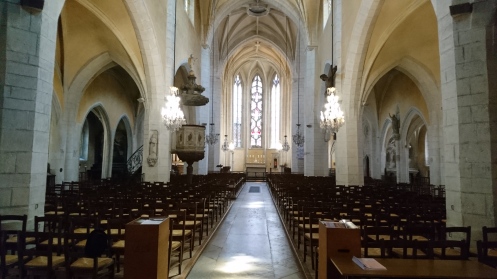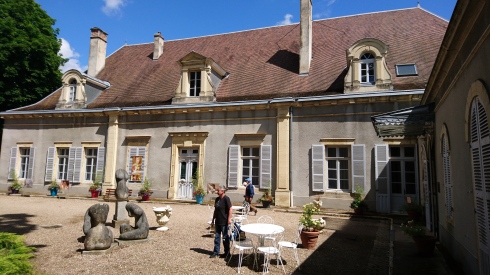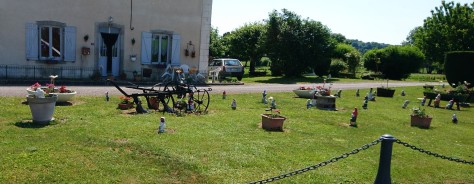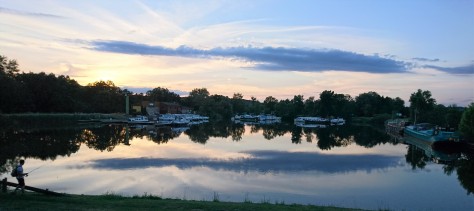We had planned to cruise directly from Gray to Auxonne but the forecast was for a day or two of foul weather and possibly heavy rain, so we decided to get off the river to a little mooring at Maxilly, a short detour up the Canal entre Champagne et Bourgogne. There’s nothing much there, with a factory on the road opposite the mooring and the village a short bicycle ride away, but it was pleasant enough. To operate the electricity and water we had to cycle to the village, where we could buy tokens at the mairie, the boulangerie, and the hairdresser. The mairie and the boulangerie were closed, it being Saturday afternoon, but the hairdresser was open, so no problem. There is never a problem with a village hairdresser in France!

As we settled into our mooring, thinking about what we might cook for dinner, a van pulled into the carpark, at about 5.00pm. Over the next hour, an assortment of cars also pulled in, the driver or passenger approaching the van, before leaving again. Had we stumbled across a drug dealer’s rendezvous? After all, this was more or less in the middle of nowhere, not a town square or main street but a featureless road between one small village and its neighbours. With some trepidation we approached the van for a better look. It turned out it was a woodfired pizza truck! The drivers had been placing their orders, to be picked up at an assigned time. So we did the same. Two fabulous artisan pizzas, full of flavour, cooked to perfection, enjoyed on our deck in the last rays of sunshine before the bad weather rolled in.

When the weather cleared after a couple of days, we continued our journey down the Saone, to Auxonne – an interesting town which is well worth spending time in. It has a long history as a garrison town and was one of the chief defensive centres of Louis XIV’s noted military engineer Vauban: today the headquarters of the 511th Logistics Regiment, it was once home to an Artillery School where a young Napoleon Bonaparte first trained.
There are three choices for mooring in Auxonne; we ignored the well-appointed but expensive marina at Port Royal, and we also passed on the municipal pontoons where space was tight and in any case the services were switched off (damaged by that year’s winter floods, we think). We settled on mooring on the stepped quay just downstream of the old bridge, immediately by the Château d’Auxonne. This spot requires care with varying water levels but we figured we’d be OK, as long as we were also vigilant about wandering locals.
Auxonne has some excellent historical architecture – civic, military, domestic and religious. The Chateau d’Auxonne has elements dating from Louis XI, Louis XII and Francis i (15th/16th centuries) and was significantly enlarged and strengthened by Vauban under Louis XIV in the 17th century. The Eglise Notre Dame was commenced in the 13th century, with side chapels added in the 14th/15th centuries and the “crooked spire” of slate added in 1858. It has some impressive gargoyles!
Notable civic and domestic buildings include the hotel de ville (town hall), originally built in the XVth century for the Dukes of Burgundy; some half-timbered houses from the 15th century, and a set of fine turned-wood stairs and balustrades from the 16th century on another old house. There are also various remnants of military construction from across the centuries – ramparts, gates and towers.
We particularly liked the half-timbered house of a local plumber, especially his unique but typically French sign advertising his trade.
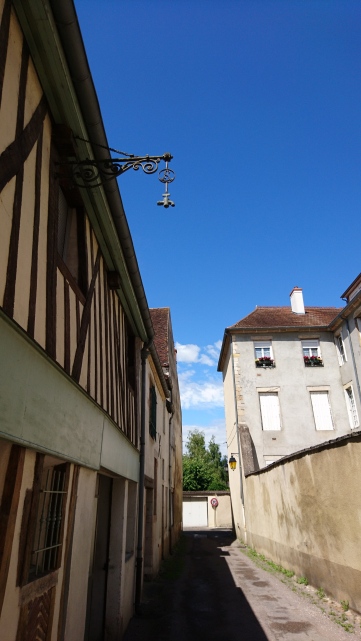
We stayed two nights in Auxonne and, sure enough, the stepped quay where we moored was a popular hangout with young locals and fishermen, though it didn’t really cause too many problems. On our second day we were amazed to see the size of the fish one man pulled out of the river… absolutely massive, on a standard hand line. The river is apparently full of these monster catfish! (We thought the girl with the pink hookah was an interesting touch as well)
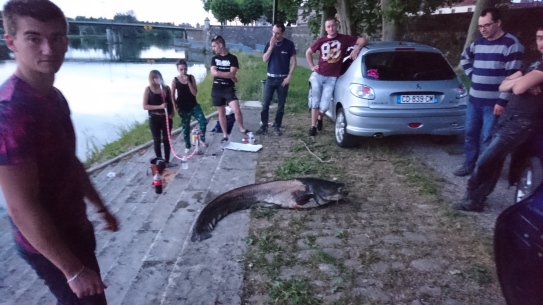
Auxonne has a number of excellent choices for dining, whether lunch or dinner (no catfish on the menu), but we recommend the Restaurant des Halles, where we had an excellent meal in the sunshine of the town square opposite the church.
From Auxonne we travelled down the Sâone to Saint-Jean de Losne, the self-styled “centre of the French waterways”, so-called because it is a convenient stopover or departure for trips along several routes – down the Rhône towards Lyon and the south of France, north up the Sâone, or up the Doubs towards the Rhine, or along the Canal de Bourgogne or the Canal entre Champagne et Bourgogne. The town itself is pleasant but fairly unremarkable, except for the large gare de l’eau or marina, several ateliers des bateaux or marine workshops for repairs and maintenance both light and heavy, and a large number of boats for sale.Almost everyone who travels the French waterways for more than a season or two ends up spending time at Saint-Jean. We moored on the stepped quay on the river, very pleasant and handy to the several options for riverfront dining along the quay. Our choice generally was Bistrot La Cotinière.
Having reached the wide reaches of La Basse Sâone, we became aware of how much commercial traffic the river still sustained. Every day brought a multitude of vessels large and small – peniches, massive cargo vessels (mostly carrying construction materials) and river cruise vessels.
Like many other places along French waterways, it was also a place where swans expected to be fed.

Saint-Jean was to be our last stop on the river, as we turned westwards along the Canal de Bourgogne.


















